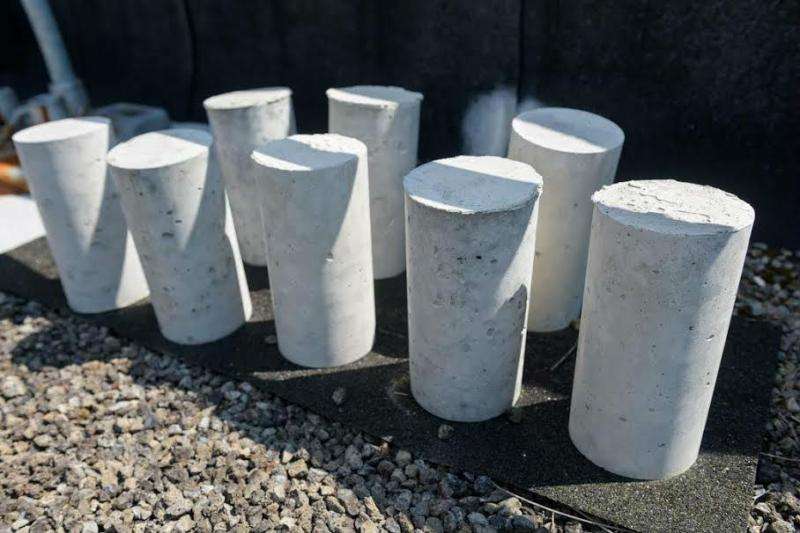Tough microbe settlers in the concrete jungle

It is easy to forget that much of our cities—the sidewalks, buildings, bridges, and runways—are made from the world's most common building material: concrete.
And, at first glance, concrete is not a hospitable environment. Freshly poured, concrete has a pH of 12.5, the same as bleach, and once it hardens, concrete is dry and salty. Despite the forbidding setting, many types of microbes survive on and in concrete, and many concrete-dwelling microbes are similar to species found in naturally alkaline, salty environments, according to a new study. The discovery could lead to a new method for detecting structurally unsafe concrete.
"The microbes that live on concrete have to withstand not only the conditions that are there all the time, like the pH and the salt, but also big temperature swings. It makes it a very challenging environment," says University of Delaware microbiologist Julia Maresca, who will speak on the subject on Wednesday, 28 September, at the meeting of the Geological Society of America in Denver, Colorado. "I thought it might be a really interesting place to look for microbes and see what their coping mechanisms are."
Maresca and her colleagues wanted to identify the groups of microbes living in and on concrete by extracting their DNA from concrete. The scientists placed small concrete cylinders on the laboratory roof, exposing the cylinders to the effects of natural weathering. After 12 months, they smashed the cylinders and attempted to extract microbial DNA from the remnants. They quickly discovered that positively charged molecules such as silicon, calcium, and potassium in the concrete glommed onto the DNA, making the DNA impossible to extract.
"I told my student, 'Think about something that is similar to concrete in its physical characteristics,'" says Maresca. "She thought about what might be dry and high in calcium, and we ended up adapting a method used to extract DNA from ancient bones."
Overall, the types of bacteria found living in or on concrete were similar to microbial groups growing on rock surfaces and stone monuments. The researchers found a large number of microbes in the Actinobacteria family, which usually have tough outer membranes, in the concrete. This bacterial group often forms dormant cells that lie quiescent until favorable growing conditions develop.
"It kind of makes sense that they would be in an environment that is not very friendly," says Maresca.
Some of the bacteria found in and on concrete are related to microbes that live in soda lakes, which have a high pH, and saline lagoons or on rock surfaces; environments that share characteristics with concrete. The researchers also found a number of microbes from the Geodermatophilaceae family, which commonly live on rock surfaces and in deserts.
The lab cultivated a number of bacterial species, proving that at least some of the DNA originated from living bacteria and not dead bacteria mixed into the concrete during construction.
Furthermore, the researchers discovered that the same groups of bacteria grew on the outside of the concrete cylinders as the inside. "These findings imply that weather and atmospheric deposition likely have little influence on the composition of the microbial community growing on concrete," concludes Maresca. Instead, the chemical makeup of the concrete likely drives community composition.
The team also found that concrete has a low microbial biomass. They estimate that 1 gram of concrete contains an average of 1,000 to one million cells compared to the 10 billion cells found in one gram of soil.
Maresca is in the process of analyzing data from a second experiment that tests whether microbial communities shift as concrete degrades due to a reaction between the components of concert referred to as the alkali-silica reaction (ASR). Specifically, the alkaline cement paste reacts with silica-laden sand or gravel. Preliminary results indicate that the microbial communities in concrete do change over time, and that the community in ASR-prone concrete differs from that in "healthy" concrete.
If Maresca can identify shifts in microbial communities as concrete breaks down, she might be able to create a bio-indicator for concrete degradation caused by ASR, a field test that would alert structural engineers to the presence of microbes associated with damaged concrete.
"There are a lot of chemical changes that precede visible structural damage," says Maresca. "If the microbial community in or on concrete changes in response to these chemical changes, we might be able to use them as an early warning indicator."
More information: Abstract: gsa.confex.com/gsa/2016AM/webp … ram/Paper280245.html
Provided by Geological Society of America


















